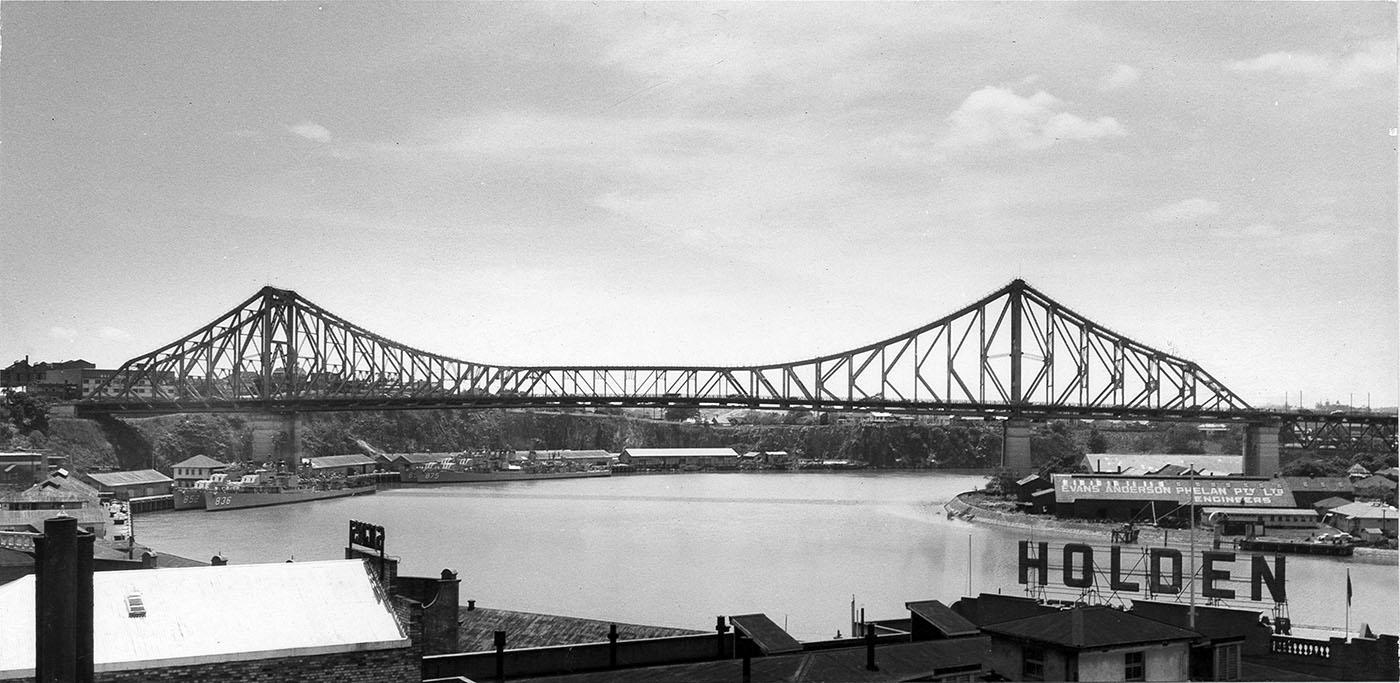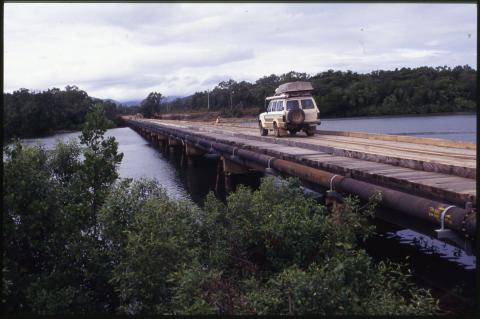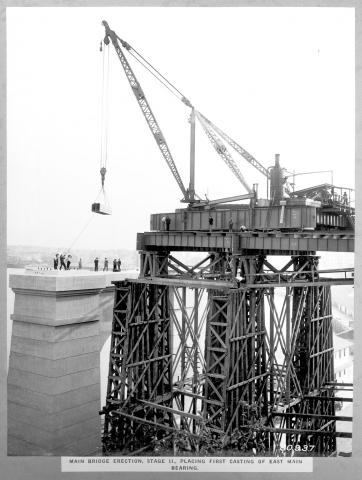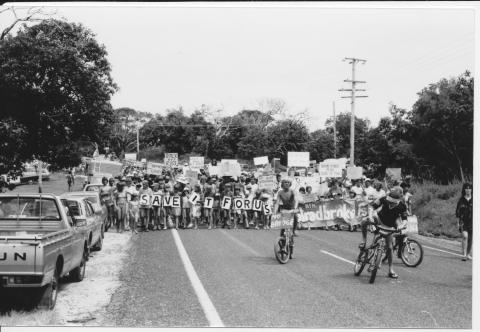
- News of the Day
-
Maryborough Chronicle, Wide Bay and Burnett Advertiser, Monday 8 July 1940, page 4
OPENING OF STORY BRIDGE
BRISBANE, July 7.— A distinguished crowd saw the Governor (Sir Leslie Wilson), cut a red ribbon and declare the Story Bridge open for traffic yesterday.
"This great and graceful structure is not only a bridge," said his Excellency. "It was the means of bringing into being firms which are capable of great things, and it has brought to Queenslanders the knowledge that in their midst are the workmen, the material, initiative, and determination to accomplish whatever they set out to do."
Praise for the men who made the bridge came from the Premier (Mr. Forgan Smith). It was announced that the cost of the bridge, including resumptions, was £1,600,000.
The opening ceremony was performed at the northern end, and after it had concluded the Governor, State Ministers, and other leading citizens drove across the bridge to pay a cheerful toll at a combined patriotic carnival.
The Governor, whom the Premier introduced, said that the ceremony would remain historic in the annals of Queensland and its capital. The bridge was distinctly a Queensland product. It was the largest ever built of all-Australian design, material, and construction. It was all-Queensland except for the steel, and that was fabricated in this State.
MONUMENT TO GENIUS
The Story Bridge was by far the finest in Queensland, and the second longest span bridge in Australia. The Government had been responsible for the decision to put the work in hand, and Dr. Bradfield was appointed designing engineer in December, 1933.
"This great structure will be a monument for all time to Dr. Bradfield's genius and ability, just as St. Paul's Cathedral and other great English buildings are monuments to Sir Christopher Wren," said his Excellency. He coupled with that tribute the work of the Bridge Board, the Bureau of Industry, engineers, contractors, and workmen. The artisan working at a dizzy height on a structure such as the bridge deserved all the praise that words could convey, he added. The quality of the workmanship could be gauged from the fact that 1,250,000 rivets had been driven and 7000 gallons of zinc paint put on; 450 men had been employed, and only three fatal accidents had occurred.
He had been invited to name the bridge in recognition of all the service that Mr. J. D. Story had given to Queensland. He was most happy to do so. In future years the bridge's name would call to mind a man who had spent 55 years in devoted service to the people as an education official, Public Service Commissioner, and Vice-Chancellor of the University.
His Excellency, accompanied by the Premier, left the dais and unveiled a tablet on the downstream side of the bridge. After the Premier had unveiled a tablet at the other side the Governor cut the ribbon, saying as he did so: "I name this bridge the Story Bridge, and declare it open for traffic.”
There was an interlude as small pieces of ribbon were cut by his Excellency for those immediately near him. The remainder was taken by officials, and pieces will be distributed to notable citizens.
The Premier said that the bridge was part of a big project to link Coolangatta and Cooktown. Its construction was part of a rehabilitation policy which had had excellent results since 1932.
- Background
-
This steel and concrete cantilevered bridge was constructed between 1935 and 1940 by contractors Evans Deakin-Hornibrook for the Queensland Government.
As early as January 1926 the Greater Brisbane Council's Cross River Commission had recommended the construction of a bridge at Kangaroo Point. Due to sectarian interests and prohibitive costs, however, the council chose instead to erect the Grey Street Bridge in 1929-32.
In 1933 the new Queensland Labor Government amended the Bureau of Industry Act, permitting the establishment of a Bridge Board chaired by JR Kemp, Commissioner for Main Roads, to plan a government-constructed toll bridge at Kangaroo Point.
Premature in terms of traffic requirements, the bridge was promoted as an employment-generating scheme. It was one of three such projects undertaken by the Queensland Government in the mid-1930s, the others being the Stanley River Dam and the University of Queensland campus at St Lucia.
Dr JCC Bradfield, designer of the Sydney Harbour Bridge, was appointed consulting engineer on 1 January 1934. He chose JA Holt as supervising engineer for the design of the bridge and supervision of the contract. Design and site surveys were undertaken in 1934.
Although modelled on the Montreal Harbour Bridge, completed in 1930, Bradfield emphasised that the grey steel elevation of the bridge was designed to harmonise with Brisbane's natural skyline.
Tenders for the Kangaroo Point Bridge were called in January 1935. The contract was let to Evans Deakin-Hornibrook Constructions Pty Ltd, with a price of £1,154,000, and construction commenced in May.
The Story Bridge remains the largest steel bridge designed and built mostly by Australians from Australian materials. Approximately 95 per cent of the materials used were of Australian manufacture, and 89 per cent of the cost of works was expended in Queensland.
All the steelwork, approximately 12,000 tonnes, was fabricated at the Rocklea workshop of Evans, Deakin & Co. Ltd. One truss of each type of approach span, and all joints of the main bridge, were assembled at the workshop then dismantled before removal, ensuring there were no difficulties in erecting the steelwork on site.
The concrete work and erection of the superstructure was carried out on site by the MR Hornibrook organisation.
The bridge was constructed simultaneously from both ends, with the main piers erected first. Excavations for the southern pier necessitated men working in watertight airlock chambers within steel caissons up to 40 metres below ground level. This was the deepest airlock work done in Australia at the time.
The approach spans were erected by a hammer-head crane operating along a runway. Then the anchor-cantilever trusses were erected in five stages using a 40 tonne derrick crane running on a temporary track on the bridge deck. Finally the bridge was closed using a system of wedge devices inserted in the top and bottom chords of each truss at the ends of the suspended span.
During 1938, which was the busiest period of construction, close to 400 persons were employed in the workshops, offices and on site.
From mid-1935 to 1940 the bridge was known as the Jubilee Bridge, honouring George V, but when opened on 6 July 1940 it was named after JD Story, the Public Service Commissioner and a member of the Bridge Board. The designer and the chairman of the Bridge Board were honoured in the naming of the southern approach viaduct as the Bradfield Highway and the northern approach as Kemp Place.
Although an engineering success, the bridge was regarded initially as a white elephant, the toll being unpopular and the traffic demand negligible. Not until the arrival of American troops in 1942 was the Story Bridge fully utilised. Nevertheless, the final cost of £1.6 million was recuperated within seven years, and in 1947 the bridge was transferred to the Brisbane City Council and the toll was removed.
The Story Bridge has become one of Brisbane's most widely recognised landmarks. Its illumination, carried out by SEQEB in time for the 1986 Warana festival, reflects its unique status as a symbol of the city.
Courtesy of the Queensland Heritage Register
/153.032335,-27.463824,7/450x450@2x.png?access_token=pk.eyJ1IjoicXNhLWRpc2NvLXFsZCIsImEiOiJjamJmdTgyZXEyeWNjMnlxZm8xcmtieHgxIn0.lmT9J5tTPKGuuccQgCVSAg)



